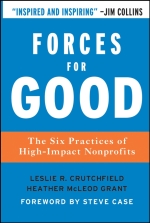 |
| Forces for Good:The Six Practices of High-Impact Nonprofits, by Leslie R. Crutchfield and Heather McLeod Grant
(Jossey-Bass, 2008, 336 pp., $29.95). |
A great untold story of our time is the rise of the social sector. That's what Leslie Crutchfield and Heather McLeod Grant assert in Forces for Good, their helpful examination of effective nonprofit organizations. To begin with, we learn that there are now an astounding 1.5 million nonprofits in the United States, and that they account for $1 trillion in revenues, making the nonprofit or "social" sector the third largest industry in the U.S. Yet in their research, the authors found a publishing world awash in studies directed at private industry but surprisingly bereft of rigorous work to guide nonprofits.
Closely following Jim Collins' Good to Great model, Crutchfield and McLeod set out to identify the practices of high-impact organizations. Through an exhaustive process (which they carefully report), they selected for study 12 organizations with substantial, sustained results that created real social change.
It soon became clear that traditional metrics like cost ratios or budget growth were not what set high-impact nonprofits apart. Moreover, internal strengths like capital and infrastructure were not sufficient to earn them the "high-impact" label, although these are consequential and merit a chapter in the book. The crucial characteristic, though, was that the high-impact organizations adopted practices that forced them outside of their own walls: The urgent message of this book is that "greatness has more to do with how nonprofits work outside the boundaries of their organizations than how they manage their own internal operations."
Six breakthrough practices emerged from the research, and they are exhaustively — sometimes laboriously — described. However, the volume is nicely organized to serve both the busy reader who wants to skim for the highlights and the diligent one who prefers more depth.
What are the breakthrough practices of high-impact nonprofits?
-
Engage in both advocacy and service, involving the government sector in social change.
-
Harness market forces by mining the interest of businesses in doing well while doing good.
-
Inspire evangelists by creating meaningful ways to engage individuals.
-
Nurture nonprofit networks with a clear focus on advancing the cause.
-
Master the art of adaptation, responding to changing circumstances with one innovation after another.
-
Employ a shared-leadership model.
The authors profile a diverse sample of organizations, providing case studies of familiar groups (like Teach for America) alongside less known ones (like the Center on Budget and Policy Priorities). The selection criteria explicitly excluded religious organizations, but the material nevertheless presents an excellent opportunity for religious organizations in general, and theological schools in particular, to think openly and critically about what these strategies mean for them.
The breakthrough model invites approaches for theological schools. It encourages boards to ask how effectively theological schools have listened and responded to the changing environment, whether they have attracted strong, skilled leaders, and in what ways they have maximized the power of already-existing networks. It might even encourage boards to brainstorm creative ways for government and business to be allies in the transformative work of theological education.
"The most powerful, influential, and strategic organizations transform others to become forces for good," write Crutchfield and McLeod. Such impact is at the very heart of the work of theological schools. Forces for Good challenges the church and its theological schools to grapple with new ways to approach the work of empowering people to be agents of God's transformative work in the world.